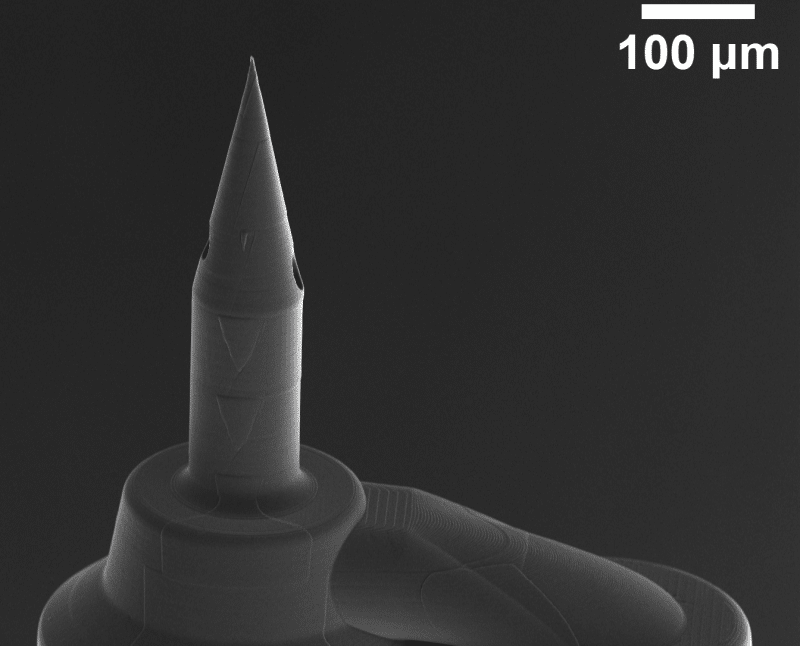Researchers at Columbia University Irving Medical Center (CUIMC) have unveiled what might just be the world’s most precise needle—a groundbreaking innovation capable of delivering therapies directly into the cochlea, the delicate spiral-shaped organ responsible for hearing.
This advancement could open the door to a new era of treatments for hearing loss and related auditory disorders.
Why Precision Matters in Cochlear Treatments

The dual-lumen microneedle as seen through an electron microscope. Image credit: Jeffrey Kysar/Columbia University.
The cochlea is an incredibly small and sensitive structure, protected by a bony casing and filled with fluid. Delivering therapeutic agents directly into this space without causing damage has been one of the biggest challenges in hearing loss treatment. Until now, most drug delivery systems relied on indirect methods, which often resulted in suboptimal drug distribution and limited therapeutic impact.
The newly developed needle is not only ultra-thin but also designed to penetrate the cochlear membrane with extraordinary precision. It ensures that medication is delivered directly to the targeted area within the cochlea, minimizing risks of leakage, damage, or unintended side effects.
“It’s not an exaggeration to say our microneedle could be key to precision medicine for the inner ear”
–Dr. Anil Lalwani, one of the lead researchers on the project
Clinical Potential: From Research to Real-World Application
The needle was tested in preclinical studies, demonstrating its effectiveness in delivering therapeutic agents with remarkable accuracy. According to findings published in Science Advances, the needle was able to access the cochlear compartments without causing any significant trauma, a critical factor in ensuring patient safety.
This innovation could be particularly impactful for patients with sensorineural hearing loss, a condition often caused by damage to the hair cells or auditory nerve. Direct cochlear delivery opens up possibilities for gene therapy, regenerative medicine, and even the targeted delivery of neuroprotective drugs.

Cells in the cochlea after injection via the microneedle of a gene therapy vector (bottom row) and a control solution (top row). Image credt: Anil Lalwani and Jeffrey Kysar/Columbia University.
In reference to recent studies, researchers have also highlighted how precision drug delivery could complement other advancements in hearing restoration therapies, such as cochlear implants or inner ear stem cell treatments.
Overcoming the Challenges of Cochlear Drug Delivery
One of the biggest limitations in treating hearing loss has been the inability to deliver medications directly into the cochlea without causing damage. Traditionally, treatments have involved systemic drug delivery, which often fails to reach therapeutic concentrations in the cochlea. Localized drug delivery with this needle represents a potential paradigm shift in treating hearing-related conditions.
“We’re no longer limited by the structural barriers of the inner ear. This technology allows us to bypass those challenges and deliver treatments exactly where they’re needed,” Dr. Lalwani explained.
What’s Next? Moving Towards Clinical Trials
While the results from preclinical studies are promising, the next step will involve clinical trials to test the safety and efficacy of this technology in human patients. Researchers are optimistic that this needle could become a standard tool in the treatment of various auditory disorders in the near future.
In addition to hearing loss, the technology could potentially be adapted for other inner ear disorders, including Ménière’s disease and tinnitus, offering targeted treatment options for previously challenging conditions.
This breakthrough represents not just an engineering feat but also a step forward in personalized medicine for hearing care.
“This innovation has the potential to change the way we think about and treat inner ear disorders, bringing us closer to lasting solutions for millions of people worldwide.”
–Dr. Anil Lalwani
For more details, read the full article from Columbia University Irving Medical Center here.
Source: CUIMC
**featured image credit CUIMC






